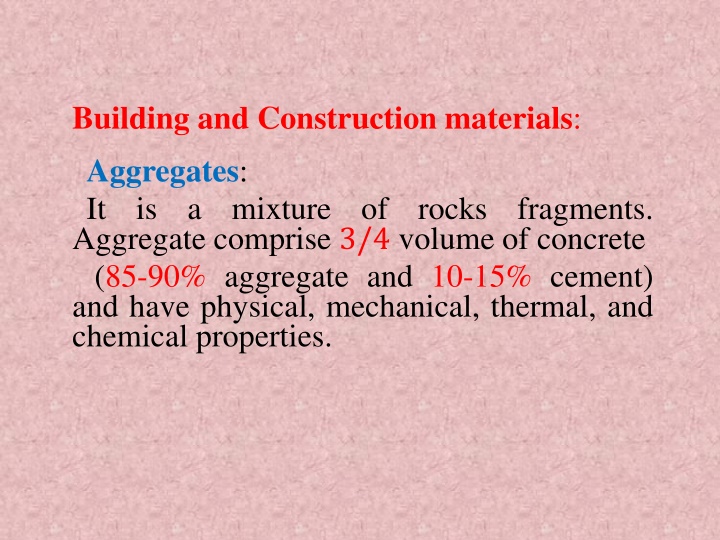
Building and Construction Aggregates
Learn about aggregates, a key component in construction materials. Discover the classification of natural and artificial aggregates, as well as different particle shapes, surface textures, and grain sizes. Explore the properties and sources of aggregates used in various construction projects.
Download Presentation

Please find below an Image/Link to download the presentation.
The content on the website is provided AS IS for your information and personal use only. It may not be sold, licensed, or shared on other websites without obtaining consent from the author. If you encounter any issues during the download, it is possible that the publisher has removed the file from their server.
You are allowed to download the files provided on this website for personal or commercial use, subject to the condition that they are used lawfully. All files are the property of their respective owners.
The content on the website is provided AS IS for your information and personal use only. It may not be sold, licensed, or shared on other websites without obtaining consent from the author.
E N D
Presentation Transcript
Building and Construction materials: Aggregates: It is a mixture Aggregate comprise 3/4 volume of concrete (85-90% aggregate and 10-15% cement) and have physical, mechanical, thermal, and chemical properties. of rocks fragments.
Aggregates classify according to source to: 1- Natural aggregates (sand and gravel): it is extracted from quarries, which was formed by disintegration of rocks (igneous, sedimentary, & metamorphic) through weathering, erosion, transportation of fragments by (air, water, & glacier) & deposition. 2- Artificial aggregates (slag, crushed stone): it is formed by: 1- By-product (blast furnace slag, fly ash, burned rocks) 2- Thermal process (fired clay, vermiculite) 3- Recycled concrete and municipal wastes
Natural aggregates classify according to particles shape about BS 812 / 1975 to: 1- Rounded 5- Elongated 2- Irregular 6- Flaky & Elongated 3- Flaky 4- Angular Natural aggregates classify according to surface texture of grains about BS 812:1975 to: 1- Glassy (flint) 3- Granular (sandstone) 5- Crystalline (granite) 6- Porous (pumice) 2- Smooth (chert) 4- Rough (basalt)
grain size Natural according to classification of Wentworth scale and British institute of geological science to: aggregates classify about 1- Grains size > 4mm are called gravel (pebbles, copples, boulders) composed of rock fragments. 2- Grains size 4 - 0.063 mm are called sand composed mostly of quartz. 3- Grains size < 1/16 or 0.063 mm known as fines consist of silt and clay fractions.
